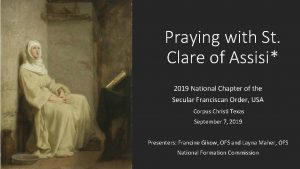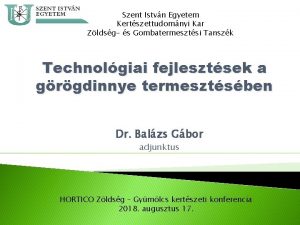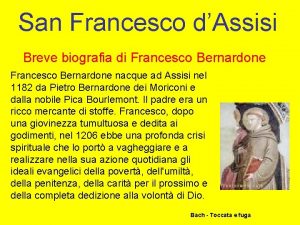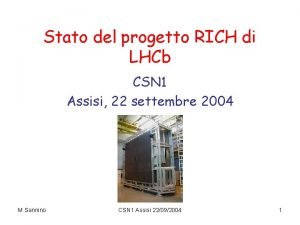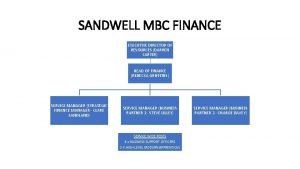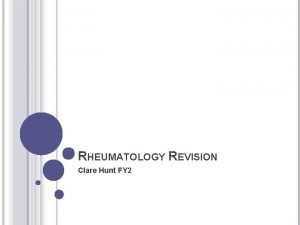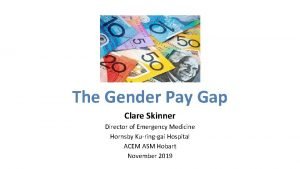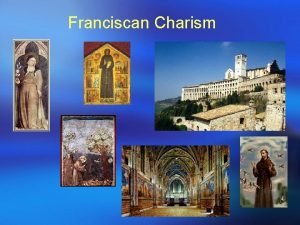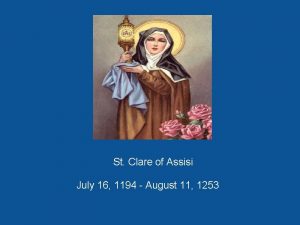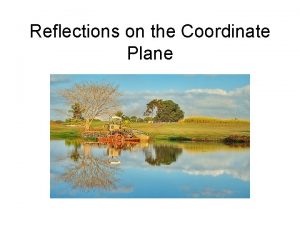St Clare of Assisi Reflections 1 St Clare



















- Slides: 19

St. Clare of Assisi - Reflections 1

St. Clare of Assisi n Basic Background Clare of Assisi (1193 -1253) can be defined as the feminine expression of the ideals of Francis of Assisi. Her name means "the enlightened one"'. Her life was often seen against the background of the radical Gospel ideals of Francis. It is only since 1953, and during the 8 th centenary of her birth in 1993 -94, that Clare has emerged as a unique contribution to the ideals of Francis. Clare often called herself "the little plant of the most blessed Francis" (Rule I, 3; Testament 37. 49). Her ideals matched those of Francis, but they are the expression of an authentically female approach to the Gospel, and radical 2 evangelical living.

Clare’s early years n Clare was born in 1193 -94, in a noble family, in Assisi. Her father was Favarone di Offreduccio di Bernardino, and her mother's name was Ortolana. This pious woman was convinced that her daughter would be "enlightened" by God, and hence called her Clare, after being assured of a safe delivery in a vision. Clare's childhood years were marred by some sad events, notably the ransacking of the Rocca Maggiore by the Assisi citizens in 1198 and the war between Assisi and Perugia. During these years, when Clare was still a child, the nobility had to flee from Assisi and her family had taken refuge in Perugia. Clare grew up as an educated young lady as befitted her noble status. From her mother Ortolana she learned to become a woman of prayer, with a gentle heart, generous towards the poor. These qualities were later to become the salient points of her spirituality. 3

Countryside of Assisi 4

Clare: Influenced by Francis n Back in Assisi in the early years of the 13 th century, Clare soon became aware of the fresh ideals of Francis and his brothers, who were living down at the Porziuncola. She longed to become a member of the new movement, but she was a noble woman, and her only choice would have been that of joining one of the great monastic Orders for females, notably the Benedictines. n After a period of reflection, during which Clare met Francis on some occasions, and most probably with the consent of bishop Guido of Assisi, Clare decided to choose a life of radical evangelical poverty. 5

Clare: Following her dream n During the night of Palm Sunday (28 March 1211 or 18 March 1212, according to different chronological tables), Clare escaped from her family's home in Assisi and hurried down to the Porziuncola, where Francis gave her the habit of penance at the feet of the altar of the Virgin Mary of the Angels. That same night Clare was escorted to the Benedictine monastery of San Paolo in Bastia Umbra, where she was protected by papal interdict against possible intrusion by her family to take her back home by force. Francis later transferred her to another monastery at the foot of Mount Subasio. There Clare was joined by her sister Caterina (Sister Agnese). n All attempts by the paternal uncle Monaldo to take back the two girls by force proved futile. Francis then sent Clare and Agnese to the small church of San Damiano and gave them a Form of Life, which is the basis of the Rule of St. Clare. San Damiano was to be the place where Clare lived a cloistered contemplative life, until the day of her death in 1253. The first sisters to join her 6 would be called the Poor Ladies of San Damiano.

Chapel of San Damiano 7

First community of the Poor Ladies n Clare and her Sisters were the product of Francis' evangelical initiative. They were so close to the Friars Minor that they were also known by the name "Lesser Sisters". Their way of life was a cloistered one, but not in the style of the old monastic Orders. The cloister at San Damiano was more spiritual than material. Moreover, the Poor Ladies lived close to the cities, and seemingly in close collaboration with the apostolic work of the Friars Minor, of whom they shared the zeal in a contemplative attitude. n The Poor Ladies were quite unlike other female religious movements, in the sense that they had no property. The Privilege of Poverty could be seen as the characteristic note of Clare and the Poor Ladies of San Damiano. 8

Clare: Holy Poverty n The reason for this insistence upon voluntary radical poverty lay in the fact that the Church was continually insisting that Clare and the Sisters accept a more stable way of life according to the canons of monastic Orders. This would have included property in common. Clare resolutely refused this condition, she continued to insist, and went even as far as taking the initiative of writing a Rule modelled upon the Later Rule of the Friars Minor. This Rule was finally approved by Pope Innocent IV himself on 9 August 1253, just two days before Clare died. 9

Clare: Abbess of the Poor Ladies n The years which Clare spent in San Damiano were marked by the spreading of her movement. In 1219 her sister Agnese was sent to found the monastery of Monticelli, near Florence. Clare's ideals travelled far and wide, especially with the help of the first Franciscan missionaries to northern Europe. In 1234 the Poor Ladies had a monastery in Prague (Bohemia), where the princess Agnes took the penitential habit and began to live in radical poverty according to the style of the Poor Ladies at San Damiano. Four letters which Clare wrote to Agnes of Prague have been handed down to us. Clare was frail in physical health. Since 1224 she was always ill at San Damiano. Nevertheless her strong character and youthful spirit never left her. She welcomed Francis, who was blind, at San Damiano in the spring of 1225. There he wrote the Canticle of Creatures. To her and the Sisters, Francis directed his Last Will before dying, and his funeral cortege stopped at San Damiano for a last farewell by Clare and the Poor Ladies on Sunday 4 October 1226. 10

Clare’s final farewell n n As the day of her death approached, Clare twice received the visit of Pope Innocent IV himself and begged him to approve her Rule. This he did on 9 August 1253. Two days later, on 11 August, Clare died at San Damiano. Her last words are recorded by Sister Filippa, the third witness in the Process of Canonization: "Go calmly in peace, for you will have a good escort, because He who created you has sent you the Holy Spirit and has always guarded you as a mother does her child who loves her. O Lord, may You Who have created me, be blessed" 11 (Proc III, 20).

Clare: Contemplation Reflections taken from the writings of Clare in her Letters to Agnes. n Become what you contemplate ‘Place your mind before the mirror of eternity! Place your soul in the brilliance of glory! Place your heart in the figure of divine substance! And transform your whole being into the image of the Godhead itself through contemplation. ’ 12

Clare: Contemplate n Contemplate the morning. n Contemplate the evening Cause me to hear thy loving kindness in the morning; for in thee do I trust: cause me to know the way wherein I should walk; for I lift up my soul unto thee. Psalms 143: 8 13

Clare: Receive from God and trust in Him n The most holy virgin, Clare speaks within herself and silently addresses her soul. “Go without anxiety. ” she said, “for you have a good escort for your journey. Go, ” she says, “for He who created you has made you holy. And, always protecting you as a mother does her child; He has loved you with a tender love. ” “May you be blessed O Lord” she says, “You who have created my soul!” n He who has created you, has also sanctified you 14

Clare: Receive God from others n The Son of God has become for us the Way that our blessed father Francis, His true lover and imitator, has shown and taught us by word and example. n Therefore, beloved sisters, we must consider the immense gifts that God has bestowed on us, but among other, those that He has seen fit to work in us through His beloved servant, our blessed father Francis, not only after our conversion, but also while we were still in the unhappy vanity of the world. (Test Cl 5 -10) 15

Clare: Cling to God n For love of Him to Whom you have offered yourself as a holy and pleasing sacrifice, that you always be mindful of your commitment. n Always remember your beginning. 16

Clare: Receive some persons to love n Open space of the embrace n “Only the love of God poured out in our hearts” can spell out the friendship, which within His infinite riches, he gives us to share through our awkward gestures and words. 17

Clare: Allow yourself to be transformed n n n Become listening Become love Become prayer Become free Become life Become a blessing Excerpts from 15 days of prayer with Saint Clare of Assisi By Marie-France Becker, OPC 18

Clare: Become what we love 19
 Assisi and ohito meetings
Assisi and ohito meetings Terremoto assisi 2016
Terremoto assisi 2016 Assisi időjárás
Assisi időjárás Bernardone san francesco
Bernardone san francesco Assisi poem annotated
Assisi poem annotated Assisi
Assisi Past paper
Past paper Italov
Italov Terremoto assisi 1997
Terremoto assisi 1997 Clare parnell
Clare parnell Robert pattinson is an american actor and musician
Robert pattinson is an american actor and musician Strategic finance
Strategic finance Dish curtin
Dish curtin Dr clare murray
Dr clare murray Clare madge
Clare madge Clare dudman lambeth
Clare dudman lambeth Double vision
Double vision Clare kershaw
Clare kershaw Clare fy
Clare fy Dr clare skinner
Dr clare skinner

